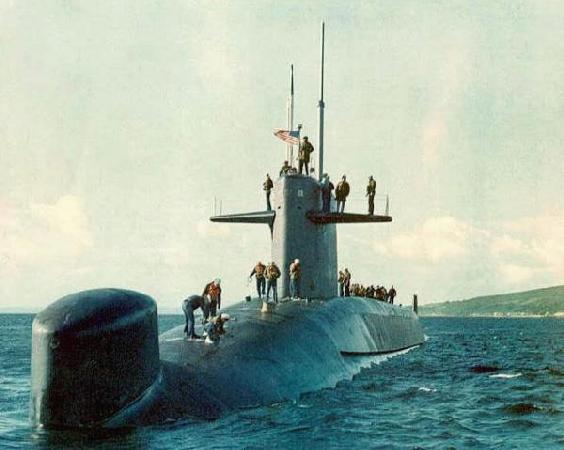
SSBN-610 Firth of Clyde, Scotland,
circa 1963
Image from EDISON
pics a webpage from B.R.
Barbee

SSBN-610 Firth of Clyde, Scotland,
circa 1963
Image from EDISON
pics a webpage from B.R.
Barbee
Cold War Sub Piano Part of New Museum Exhibit Story Number: NNS030618-12 Release Date: 6/18/2003 6:02:00 PM By Anika Richburg, Naval Historical Center Public Affairs Source http://www.news.navy.mil/search/display.asp?story_id=8039 WASHINGTON (NNS) -- The only full-size piano ever installed aboard a submarine conducting nuclear deterrent patrols is scheduled to go on display this summer at the Steinway Company Museum in New York. The exhibit, celebrating the 150 years of the famous piano company, is scheduled to display a different piano for each decade. The Steinway Company felt that this piano was of huge importance because of the historical background and the interesting events that led to its placement on the boat. “We thought it would be a point of interest. Someone contacted a dealer of the Steinway Company in Boston and told them about the piano. We felt that since there is a 150 years celebration and they are having a piano for each decade, we thought it would be very nice to have it on display,” said John Patton, spokesman for Steinway & Sons. The piano had been on USS Thomas A. Edison (SSBN 610) from the sub's construction in 1961, until it was put out of commission in December 1983. Background information about the historic piano came from former crew members recalling it on the boat, and discussing the events that led up to it being there with representatives of the Steinway Company. Lt. John G. “Black Jack” Fletcher, the Blue Crew’s assistant weapons officer with the collateral duties as first lieutenant in charge of deck seamanship remembered, "About a month before launching the Edison, the shipyard was preparing to weld shut the large hull openings left open in the pressure hull to move large equipment into the ship. One of these openings was topside centerline just forward of the sail." Capt. Cy Young told him he wanted a piano aboard, and that Fletcher would be in charge of loading it. With that, the captain proceeded to New York City and struck a deal with the Steinway Company, buying the famous piano new for $1,500. “It was a beauty, nary a scratch on its finish,” said Fletcher, but he was concerned. He was not about to be the first one to mar the piano, and so to prevent this, a special stainless steel felt lined box was made for it. Later, on a second shift (where questions were less likely to be asked), the piano box was quietly loaded through the hull opening down through the interior of the submarine, until it reached the forward bulkhead of the crew’s mess. There, the box was inconspicuously kept until the submarine was closed up. The piano was then removed from the box when all of the crew’s mess area was completed and strapped to the forward port bulkhead with stainless steel bands. Fortunately for Fletcher, no damage had occurred to the piano during its move. All this covert effort resulted in a unique form of entertainment for the crew, particularly during the Mid-Patrol Proms. Now part of the artifact collection of the Naval Historical Center, the piano is being loaned out in return for a complete restoration. As part of the restoration, the Steinway Company has agreed to clean and restore the piano to its previous working condition by restringing it. They will also refinish it to the original black lacquered finish that at some point had been removed. “The Naval Historical Center welcomes the extensive restoration of this unique artifact by its original maker,” said Mark Wertheimer, Curator Branch. |
||||